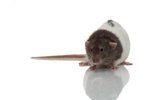
Just like humans and most animals, hamsters are susceptible to parasites -- organisms that live either on or inside a host, getting their nutrient supply from the host and often causing the host harm or discomfort. Parasites can be difficult to detect in hamsters and, though they are generally not extremely dangerous, they can cause issues ranging from weight loss and constipation to hair loss and itchiness.
Internal Parasites
The most common internal parasite hamsters contract is the dwarf tapeworm, which can take up residence in your hamster's small intestine. According to Vet Base, tapeworms may live inside hamsters with minimal problems, but occasionally weight loss and intestinal blockage can occur. More rarely, hamsters may also become hosts for small amounts of mouse pinworms, nematodes that can live in the cecum in the first section of your hamster's large intestine. Pinworms are thought to cause little distress to their hamster hosts, at most causing anal itching.
External Parasites
External parasites in the form of mites can cause a number of skin problems for your hamster. The most common culprits are Demodex mites -- two species of tiny mites that infect the hair follicles and can cause itching and hair loss. Occasionally hamsters may become infested with ear mites of the Notoedres family. These mites are specific to hamsters and cause crusting on the ears, feet, face and genitalia, according to the British Hamster Association.
Signs & Symptoms
Signs of parasitic infestation may not always be obvious, especially in the case of internal parasites. Tapeworm and pinworm infestation often have no signs at all. If you notice that your hamster has lost weight, or if constipation -- which is characterized by a lack of fecal production, as well as a swollen or discolored abdomen or anus -- occurs, tapeworms may be to blame. Symptoms of external parasites are often clearer than those of internal ones. The British Hamster Association states that dry and scaling skin, hair loss, dandruff, frequent scratching and scabbing are signs of parasitic mites. You may also notice the tiny mites moving around on your hamster's fur. In the case of ear mites, scaly lesions on the ears, feet and face are evidence of infection.
Prevention
The most important thing you can do to prevent parasites from infecting your hamster is to make sure that his hygiene is maintained. Since tapeworms in particular transmit through the ingestion of contaminated fecal matter or through flea bites, it's essential to keep your hamster's enclosure clean, sanitized and free of fleas and insects. Hamsters are fastidiously clean, and giving baths is discouraged. A sand bath -- not a powder one -- will aid his hygiene; other than that your job is just to maintain the cage regularly. Controlling the feral rodent population around your home can also help prevent parasitic infection, according to the University of South Alabama. Adequate hygiene may be prevent mites in most cases, as well, according to the British Hamster Association.
Warnings
If you notice symptoms of parasitic infections, see your veterinarian immediately. Never attempt to diagnose your hamster yourself, and never attempt to treat him without first consulting your veterinarian about the appropriate course of action. Always follow your veterinarian's directions about any treatment or medication for parasites, both internal and external.




